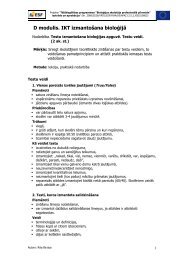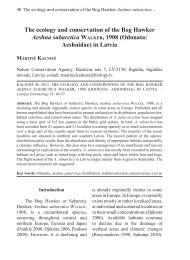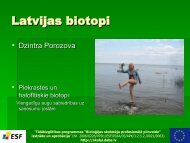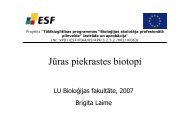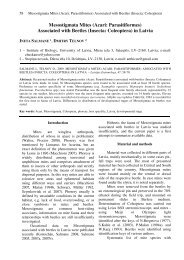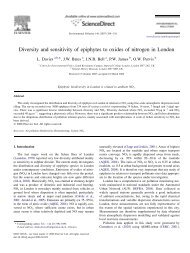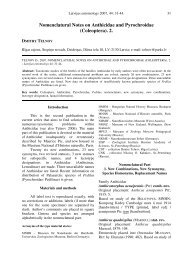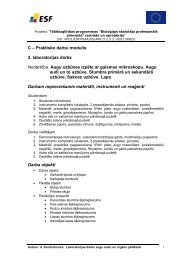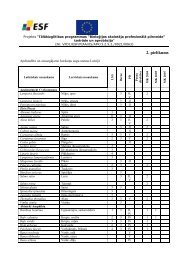Dissolved organic matter in water of Daugava river
Dissolved organic matter in water of Daugava river
Dissolved organic matter in water of Daugava river
You also want an ePaper? Increase the reach of your titles
YUMPU automatically turns print PDFs into web optimized ePapers that Google loves.
Fluorescence Approaches to Detection <strong>of</strong> Prote<strong>in</strong> AggregatesV.M.TrusovaV.N. Karaz<strong>in</strong> Kharkov National University, Kharkov, Ukra<strong>in</strong>evaltrusova@yahoo.comFluorescence spectroscopy is one <strong>of</strong> the most powerful tools for characterization <strong>of</strong> amultitude <strong>of</strong> biological processes 1 . Of these, the phenomenon <strong>of</strong> prote<strong>in</strong> oligomerizationattracts especial <strong>in</strong>terest due to its crucial role <strong>in</strong> the formation <strong>of</strong> fibrillar prote<strong>in</strong>aggregates (amyloid fibrils) <strong>in</strong>volved <strong>in</strong> ethiology <strong>of</strong> so-called prote<strong>in</strong> misfold<strong>in</strong>gdiseases. It is becom<strong>in</strong>g <strong>in</strong>creas<strong>in</strong>gly substantiated that prote<strong>in</strong> fibrillization <strong>in</strong> vivo can be<strong>in</strong>itiated and modulated at membrane-<strong>water</strong> <strong>in</strong>terface 2 . All steps <strong>of</strong> membrane-assistedfibrillogenesis, viz., prote<strong>in</strong> adsorption onto lipid bilayer, structural transition <strong>of</strong>polypeptide cha<strong>in</strong> <strong>in</strong>to a highly aggregation-prone partially folded conformation, assembly<strong>of</strong> oligomeric nucleus from membrane-bound monomeric species and fiber elongation canbe monitored with a mighty family <strong>of</strong> fluorescence-based techniques 3-5 . Little or nodamage to the exam<strong>in</strong>ed <strong>matter</strong>, requirement <strong>of</strong> material micromolar concentration, rathersimple methodology, <strong>in</strong>volvement <strong>of</strong> relatively <strong>in</strong>expensive <strong>in</strong>strumentation, highsensitivity and specificity make fluorometry a broadly used research tool for study<strong>in</strong>g theprote<strong>in</strong>-prote<strong>in</strong> <strong>in</strong>teractions. Various k<strong>in</strong>ds <strong>of</strong> fluorescence technique, namely steady-stateand time-resolved fluorescence, fluorescence polarization and fluctuation spectroscopy,stopped-flow and laser-<strong>in</strong>duced fluorescence provide the <strong>in</strong>formation about the structure,microenvironment and distribution <strong>of</strong> prote<strong>in</strong> complexes 1 . The immense range <strong>of</strong>parameters measured for both <strong>in</strong>tr<strong>in</strong>sic and extr<strong>in</strong>sic prote<strong>in</strong> fluorophores <strong>in</strong>cludesfluorescence <strong>in</strong>tensity, quantum yield, anisotropy and quench<strong>in</strong>g, lifetime, Försterresonance energy transfer efficiency (FRET) efficiency, diffusion coefficients, to namejust a few. In the present contribution the applications <strong>of</strong> fluorescence spectroscopy tomonitor<strong>in</strong>g prote<strong>in</strong> oligomerization <strong>in</strong> a membrane environment are exemplified and someproblems encountered <strong>in</strong> such k<strong>in</strong>ds <strong>of</strong> studies are highlighted. More specifically, suchaspects as fluorescence prob<strong>in</strong>g <strong>of</strong> prote<strong>in</strong>-membrane b<strong>in</strong>d<strong>in</strong>g, fluorescence monitor<strong>in</strong>g <strong>of</strong>prote<strong>in</strong> structural changes, detection <strong>of</strong> prote<strong>in</strong> aggregates with <strong>in</strong>tr<strong>in</strong>sic and extr<strong>in</strong>sicfluorophores are discussed. In addition, optimal strategies for fluorescence analysis <strong>of</strong>prote<strong>in</strong> aggregation are suggested.References:1. Lakowicz, J.R. Pr<strong>in</strong>ciples <strong>of</strong> Fluorescence Spectroscopy. NY: Spr<strong>in</strong>ger, 2006.2. Gorbenko, G.P., K<strong>in</strong>nunen, P.K.J. The Role <strong>of</strong> Prote<strong>in</strong>-Lipid Interactions <strong>in</strong> Amyloid-Type Prote<strong>in</strong>fibril Formation. Chem. Phys. Lipids, 2006, vol. 141, p. 72-82.3. Zerovnik, E. Amyloid-fibril Formation. Proposed Mechanisms and Relevance to ConformationalDisease, Eur. J. Biochem., 2002, vol. 269, p. 3362-3371.4. Domanov, Ye.A., K<strong>in</strong>nunen, P.K.J. Islet Amyloid Polypeptide Forms Rigid Lipid–Prote<strong>in</strong> AmyloidFibrils on Supported Phospholipid Bilayers. J. Mol. Biol., 2008, vol. 376, p. 42-54.5. Trusova, V.M., Gorbenko, G.P., Sarkar, P. et al. Forster Resonance Energy Transfer Evidence forLysozyme Oligomerization <strong>in</strong> Lipid Environment. J. Phys. Chem. B, 2010, vol. 114, p. 16773-16782.- 31 -



